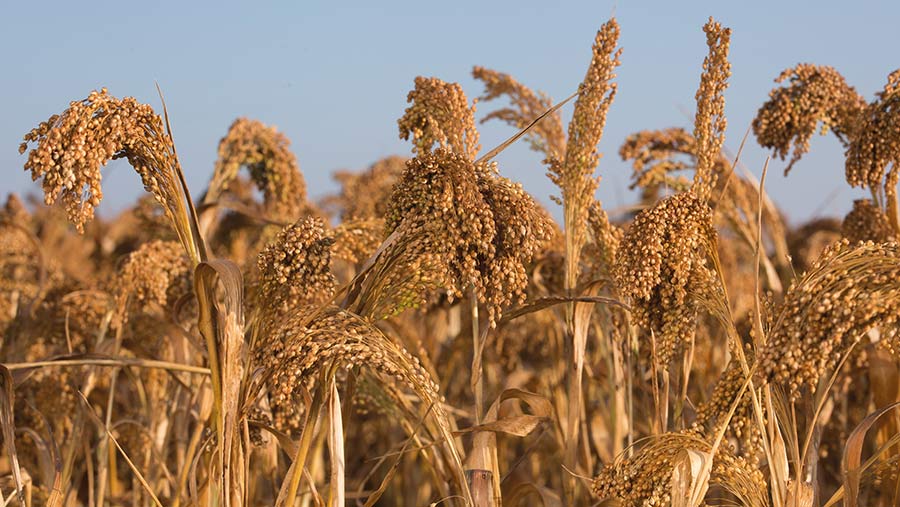Ukraine export disruption creates gap in UK millet market
 © Tim Scrivener
© Tim Scrivener The UK imported 70% of its millet from Ukraine before the Russian invasion, and with all exports from the country halted, farmers could profit from more home-grown millet this season.
Limited supply has consequently pushed prices upwards to £425/t, creating new opportunities for domestic production.
As supplies from Ukraine remain dramatically affected and other export nations including France, Egypt and China run low, there is scope for the UK to more than double its area grown.
The UK typically requires 12,000t of millet annually, of which 3,000-4,000t is grown locally by 100-200 growers (depending on contract availability). The aim is to plant an additional 1,600ha of millet this spring.
See also: Why growers should consider growing borage in 2023
Millet in the UK
Like maize, millet is a C4 combinable crop, which means its alternate photosynthetic pathway makes it suited to warmer and sunnier climates.
Millet is commonly grown for the birdseed market, and its gluten-free grain is desirable for human consumption. It is also grown as feedstock for anaerobic digestion plants.
The main variety of white millet grown in the UK is Mammoth, which is specifically bred for UK conditions.
It suits most soil types anywhere south of the Vale of York, as long as it is planted into warm seed-beds with a minimum temperature of 10C.
Soya UK is a major seed supplier of millet and its director David McNaughton says there is plenty of seed available.
The company offers full buy-back contracts, based on buyers-call and market value at the time of movement.
“Millet is traditionally worth about £100/t above the feed wheat price, but at £425 ex-farm, it is currently worth closer to £200 above feed wheat values,” says Mr McNaughton.
It acts as a good break crop as it is relatively cheap and straightforward to grow, with good disease tolerance and no significant pest pressures.
It also offers effective blackgrass control, thanks to its late sowing window from late April to mid-May.
“Mammoth is earlier to mature than off-the-peg American or French varieties,” Mr McNaughton says.
“It is ready for cutting in mid-September. It has good disease tolerance and is resistant to all known strains of smut. No fungicides are commonly used.”
The variety is competitive, taking just 130-135 days from planting to harvest, and grows to 1m in height. It requires 70-100kg N/ha. No pre-emergence herbicides are used – all weed control is post-emergence.
It also offers good standing ability.
Harvesting is relatively straightforward using a standard combine. However, desiccation with glyphosate is required at the end of August, ahead of a late September/early October harvest.
Millet grain is a similar size to rapeseed with a creamy-beige colour, with expected yields of 2-4t/ha. Crops are normally harvested at about 16% moisture and will require drying to 14% to meet market standards.
A significant proportion of its growth takes place between June and August, when temperatures are at their highest. Cold, exposed sites should, therefore, be avoided.
Case study: Andrew Bullock, Aston Farm, Gloucestershire

Andrew Bullock will grow the crop again this year © Andrew Bullock
Cotswolds mixed farmer Andrew Bullock was looking for an alternative break crop when he decided to grow Mammoth millet for the first time last year, and plans to grow the crop again this season.
Although oilseed rape is his predominant break crop, other options were not stacking up for him, so he decided to give millet a try at Aston Farm, near Bourton-on-the-Water.
“Peas and beans were not performing on our Cotswold brash heavy clay soils and resulted in weed burden, while linseed was difficult to combine and was affected by weevils,” he says.
Mr Bullock direct-drilled the millet with a Horsch Avatar into a sprayed-off cover crop. With a sprinkling of rain before drilling in early May, the crop went into a good seed-bed.
However, without any significant rainfall over the next two months crops struggled to establish and yield was heavily restricted.
“The crop never really started growing until the end of June when the rain finally arrived,” he explains.
“Poor establishment was purely weather dependent which restricted crop growth and yield.
“Due to such dry conditions, we achieved yields of 1t/ha but this was down to the season rather than the crop itself.”
A yield of 2.5t/ha would have been very economical, he says. “We get a price agreed on a buy-back contract with Soya UK, with a minimum contract price of £400/t.
“Last year, we received a price of £425/t.
He says that apart from the spring drought there were no troubles growing it at all.
“With seed, fertiliser, herbicide and a spray of glyphosate as the only inputs, it’s certainly a profitable break crop option.”
A total of 70kg of N was applied in a 50:50 split – the first down the spout at the time of drilling and the second once the tramlines were visible.
No fungicides or insecticides were applied, just a broadleaf weed herbicide.
Mr Bullock says: “The late-drilling offers excellent cultural control for blackgrass, but this is the only control method as graminicides cannot be used as this would otherwise kill off the millet.
“A few patches of wild oats appeared but we went through with a weed surfer, as one of our other farms is organic, which successfully cleared it up.”
Harvest
When it came to harvest in early October, Mr Bullock says it was “simply a doddle”.
“We sprayed the crop off with glyphosate, waited for it to dry and it cut so easily. We aimed to leave the crop to dry for about three weeks but due to the weather it was more like four.”
It was harvested on a sunny afternoon at the beginning of October at 18-19% moisture and was dried down to 14% in the grain dryer.
The straw was chopped and wheat was direct drilled into the clean seed-bed with no volunteers or weeds. The only drawback was lower residual N levels as the crop is not a legume, Mr Bullock says.
“We’re giving millet another go this year and, hopefully, we get better weather this spring to get the crop up and away. If successful, we will increase the area of the break crop grown on farm.”

